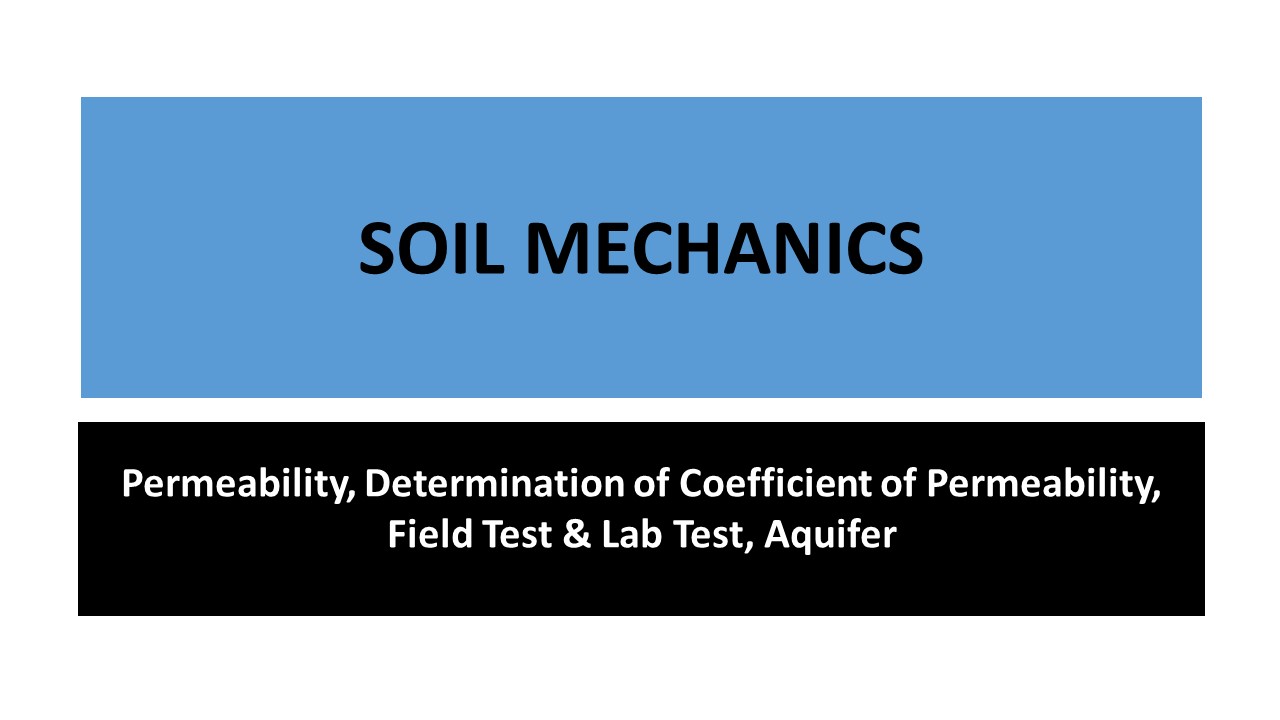Water has the most significant effect on the behavior of soil.
Gravitational water:
- Percolates through the soil under gravity
- Pore water pressure at GWT = 0
- Soil above GWT is saturated by capillary action (pore water pressure is tensile and negative = -ϒwh)
- Above GWT – impervious formation above- local saturation
- Water occurring at local saturation – perched water
Held water:
- Water held in soil pores other than gravity.
Types of Held Water:
Structural Water
- Remains in the crystal structure of soil minerals chemically, cannot removed by normal drying (105-1100C)
Hygroscopic Water
- Removed by normal drying, replaced back
- Capillary Water
- Due to surface tension
Height of Capillarity = 4T/ϒwd
Note:
Soil Suction: in case of capillary tube, water above WT has a ‘-‘ pressure, soil remains in a state of reduced pressure, known as soil suction (PF = log10(hc))
Permeability:
- Flow of water through interconnected voids.
Darcy’s Law :
Laminar flow:
- Flow follows a well-defined path and doesn’t cross the path of other particles (Re ≤ 2000)
Turbulent flow:
- Fluctuates with the time both in magnitude and direction (Re ≥ 2000)
v ∝ i
v = ki
q = vA = Aki
therefore, q= Aki
Seepage Velocity:
Seepage Velocity > Avg. Velocity (v = q/A; vs = q/As)
q = v*A = vs*As
vs =v* A/As
= v V/vs
= v/n
= ki/n
K = cd2 * (e3/(1+e)) * (ϒw/μ)
K ∝ c
K ∝ (1/μ)
{(KT/K20) = (μ20/μT)}
K ∝ e
K ∝ T (tempr)
Note:
- Impurities (salts, alkalis) increases, K decreases
- Entrapped air, k decreases
Determination of coefficient of Permeability:
(A) Laboratory Method:
Constant Head Method (k > 10-4)
- Coarse grained soil
- Constant head of water at supply tank
- Vol. of water flowing out of permeameter per unit time = q
H= head water level – tail water level
kstone > ksoil
From Darcy’s law
q = Aki
= Ak h/L
Where L = soil specimen ht.
Therefore,
k = qL/Ah
= qL/(A*h*t)
Where,
k = (k1+K2+ ………………Kn)/n
Falling head method (10-7 <K< 10-4)
- Undisturbed sample
- Fine-grained soils
- A standpipe of area ‘a’ above the cylinder
- Variable head (h1 to h2) at time t
rate of change of head = -dh/dt
Acc. Darcy’s Law
q = A*k*i
a*v = A*k*i
-a* (dh/dt) = A*k* (h/L)
After Integrating from 0 to t and from h1 to h2;
K = 2.303*(q/A) *(L/t) *log10(h1/h2)
Note:
- soil in the permeameter should be fully saturated.
Determination of Coeff. Of Permeability (Field):
(B) In-situ method:
- More reliable than the lab method
(a) Pumping test (pumping out)
- Continuous pumping from test well and observation in bore wells (observation well) till steady state.
- Min. two observation wells
- Well should penetrate full depth of water-bearing strata
Confined Aquifer – upper and lower surface impervious
Unconfined Aquifer- no overburden lying over them, top most water-bearing strata.
Unconfined Aquifer:
Observation wells – (r1 and r2 apart test well)
Ht. of observations wells – (z1 and z2)
i = dh/dr
z =ht. of water level at a distance, r
A= 2π*r*z
Darcy’s law;
q = kAi
= 2π*r*z* dh/dr
On integrating;
K = {2.303*q*log10(r2/r1)}/ {π*(zz2 – z12)}
If only one observation well;
K= {2.303*q*log10(R/rw)}/ {π*(H2 – hw2)}
R = Radius of influence
H = depth to the bottom of the aquifer from WT
Rw = radius of the test well
Hw = ht. of water in the test well
Confined Aquifer:
r, r1, r2 – same as above
z.z1.z2 – ht. from the bottom impervious layer (same as above)
b= spacing between two layers
i= dz/dr
A = 2π * r* b
q= kAi
= k * dz/dr * 2π*r*b
On integrating,
K = {q*log10(R/rw)}/ {2.727*b*(h – hw)}
R = 3000*d*√k, R in m
d = draw down, m
k= Coeff. of permeability, m/sec
(b) Bore Hole Test
Constant head method:
- Water is allowed to flow through the bottom of the bore
- Low end of the casing should not be less than 5d from the top and bottom of the stratum.
- Water level in borehole = constant
Therefore, k = q/(2.7*d*h)
Where d = dia. of well
H = head above GWT
Variable head method:
- Drop from h1 to h2
- For D ≤ 1.5 m
k = (πd/11t) * log(h1/h2)
- For D > 1.5 m
K= (πd2/81t) * log (2L/d) * log (h1/h2)
Insitu measurement of seepage velocity:
- Two trial pits A & B
- Dye inserted in A
- Observe in t time in B
h= level diff. between A and B
i = h/AB
vs (seepage velocity) =AB/t
We know;
vs =ki/n
Therefore,
AB/t =(k*h)/(n*AB)
k = (AB2*n)/(t*h)
Permeability on layered deposit:
h= h1+h2
q= q1+q2
q = kz * A * h/(h1+h2)
= k1*A*h1/h1
=k2*A*h2/h2
Therefore,
k =(h1+h2)/{(h1/k1)+(h2/k2)}
In direction of bedding;
i = i1 =i2
q = q1+q2
A*kx*i = A*k1*i + A*k2*i
k = (k1*h1+k2*h2)/(h1+h2)

